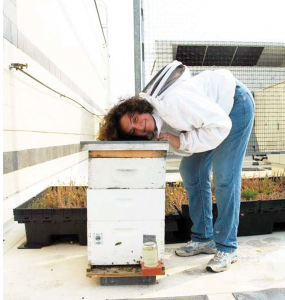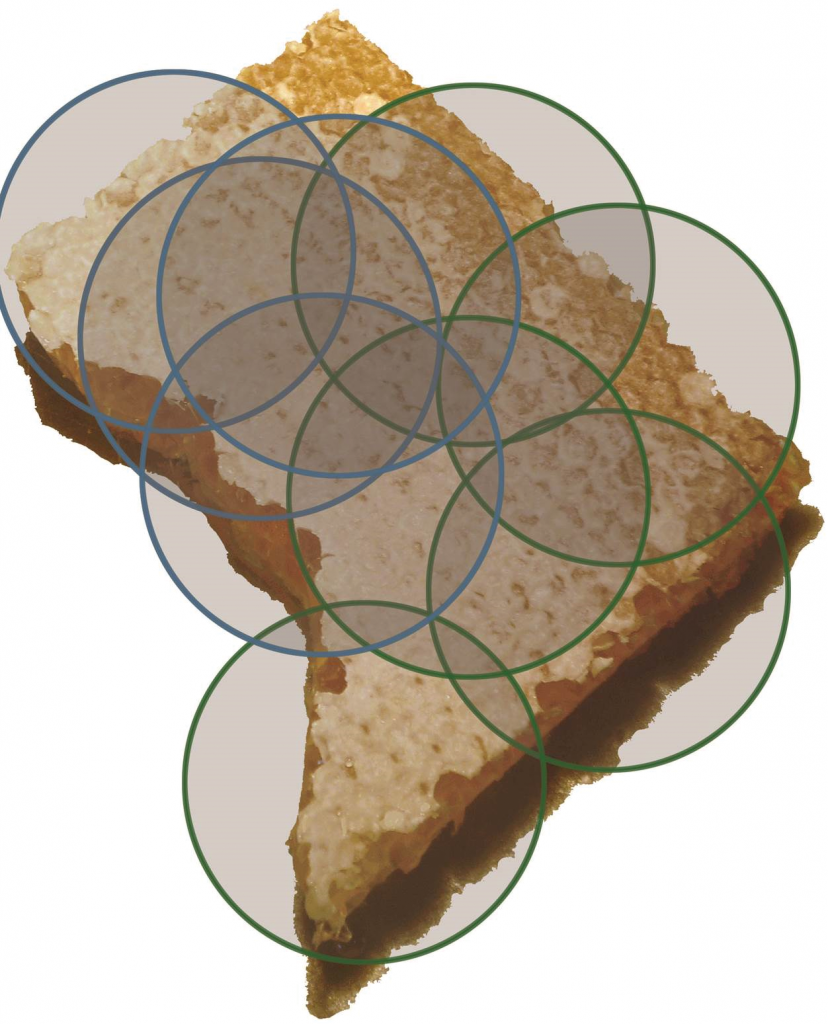Changing Fortunes For The Urban Beekeeper?
Toni Burnham
It may not have been breaking news for the average city dweller, but for urban beekeepers, it was a terrible suspicion publicly confirmed: the popularity of urban beekeeping may be tilting the fortunes of our bees toward more frequent and more damaging exposure to disease, and therefore colony loss. In November, a team including Dr. David Tarpy published a paper in plosOne: Urbanization Increases Pathogen Pressure on Feral and Managed Honey Bees (http://tinyurl.com/pfvunhc) which outlined that not the physical urban habitat itself, but increased opportunity for transmission, increases the viability and spread of disease agents. And another study, published just this month in the Proceedings of the National Academy of Sciences, (http://tinyurl.com/z8nnnew) indicates that varroa mites and the viruses they transmit enjoy a mutually symbiotic (beneficial) relationship that suppresses the immune system of honey bees.
Yikes! So there is evidence that transmission is increased between managed colonies in cities, and the organisms involved in that transmission are collaborating in their attacks on our bees. Just in case we needed more management issues.

Toni Burnham
Before I go off on my traditional rant, I want to shout out to the Tarpy team for a beautiful, well-thought out and executed study that not only found the results above, but also that feral urban bee express immune genes at about twice the level of managed colonies. In my opinion, this might be the reliable lesson of survivor stock and local adaptation. Feral bees have been living and mating locally for generations, not coming in a box from an apiary 1,000 miles away before being left to fend for themselves.
Breaking News For Urban Beekeepers
It’s not that cities themselves are bad. Just a couple of years ago, this column was about how the question of insufficient forage in the concrete jungle was overblown by the press when reporting a study out of London, England: the latter has more than 1500 beekeepers (way more per square mile than any US location) and a relatively poor percentage of pollinator-friendly greenspaces. Most US cities already do better, and some green trends (like LEED buildings, improved treescapes and native planting programs) are helping ease potential dearth. Though it needs to be said: if you have a period of dearth in your area, adding lots more colonies is one way to make it harder to address, even if there is plenty to go ëround most of the time. So one consequence of the success of urban beekeeping is increased vigilance about rainfall and bloom. Vicious cycles of robbing have occurred in patches here in recent years: so now we know to teach it in our beginnersí course, and issue reminders during the June and July meetings.
Cities used to be, in a weird way, almost virgin territory for honey bees. When I started, in 2005, I could only find a half dozen folks who kept bees (letís say there were five times as many who did not want to talk to me: that still makes less than 1 beekeeper per two square miles). My first colony loss was in Year Three at a museum in a suburb, but in Year Six, I got hammered. By that time, a couple of businesses in town reported having sold 60-100 hives a year for two years, to folks whose instruction consisted of an afternoon of PowerPoint and banging together a box. Itís safe to assume almost none of these hives saw a mite count or a Varroa treatment. And I had been kind of slack myself, what with all this crazy wintering success (I was treating WAY too late) and relatively large harvests compared to the suburbs. I also had not swapped out comb unless it was pollen bound. Until then, I had always been adding new frames and boxes, diluting whatever chemical and biological sink that might be forming. But by 2011, Iíd topped out my hive count, and most of the gear was over three years old.

This is a map of DC cut out of honey comb. Superimposed on it are the flight areas of just the apiaries that Toni manages (green circle) and that she mentors (blue) downtown. Just in her own colonies, there is an effective route of transmission from one corner of DC to the other.
The city is also not as shiny and new for bees today. It is still a growing, vibrant place with lots of potential, but like everything else around here, the decisions of the neighbors matter a lot for one’s personal welfare (like it or not) and there are more neighbors. There are absolutely ten apiaries overlapping every single hive site in DC, and at least one of them will never see a treatment before it crashes, and probably more. The phenomenon that has been discussed at the Apiary Inspectors of America meeting-and elsewhere- involves the seemingly inexplicable impact this has on hives that were treated earlier. In many cases, a hive treated in July has crashed in October, with all the signs of varroa and mite-vectored illness present. Backyard beekeepers begin to mutter about ìabsconding.î But the dynamic appears to be:
- Colonies not treated for Varroa stumble and dive fast, often growing weak under a super of honey made back in the Spring, before the mites took over;
- In the process or immediately after crashing, they are robbed out by stronger, treated hive(s);
- The strong bees bring a mother load of Varroa mites (which can hang out up to a month in a crashed hive) back home;
- The well-meaning but not-too-vigilant beekeeper who treated fails to count again after August, and receives the approximate benefit of never having treated at all: most of a sick colonyís summer-long mite harvest lives on in their woodenware; and
- The formerly strong colony gets chewed up and dies before winter, sick bees flying themselves away in the process, the beekeeper starts postulating about “absconding.”
When the beekeeper next to me at the cemetery apiary told me that he was seeing a surprise mid-summer honey flow, I thought it was about the heavy June rain. When he lost his treated hive in October, I was shocked. Oops. Sorry, Kevin, I failed you.
There is an upside to congestion, though: if we can do as the folks at BeeInformed suggested to us and get a massive, coordinated, nearly universal simultaneous Varroa treatment together across this town for late July, we can hammer the little %&@$#s, denying them safe harbor and enjoying herd health effects. There are also some cool drone flooding and similar projects we could fool with.
On the down side, we will never get to 100% (or maybe even 60%) treatment levels. Many in the city consider themselves clever and insightful actors for the common good, with access to ìauthoritativeî Internet resources, and harbor doubts about the lessons learned by others standing in front of them. (I understand that this phenomenon may not be restricted to North American cities.) Thereís also a lot of time pressure, other life stuff going on, and the excuses that everyone, everywhere uses. Many have heard that they should not treat, and they will not treat. Outside this town, there are a couple of rural apiaries with great results that do not treat, who tell everyone about it, and I hear of these in other parts of the county, as well. I think that these apiaries are run by fantastic beekeepers who have selected and managed appropriate strains of bees for years, if not decades, and though at least some of them think that the secret lies in a type of foundation, or the shape of a hive. I think that thereís more to it. They are doing potentially 100 things right, probably every week, mostly responding to the needs of the bees in the spot where the hive is placed. And their beekeeping efforts are not undercut by 20-100 nearby well-meaning newbees with mutt genes and a hands-off philosophy.
So what do I think a good response might be to mites? I hear commercial beekeepers, whose livelihoods depend on viable bees, are treating five times a year. This year my bees survived after two treatments, and not because I am some insightful genius. I chose a really ineffective method, the oxalic dribble, in July because of the temperatures we had here and the restrictions on most of the soft applications. I can also be really dense about the warnings that people tried to give. Unfortunately, I encouraged others to do so, as well.
But my buddy Jan got obsessive about taking mite counts, and posting them, and our shared treatment choice was clearly not working. So I circled back, became frightened, and applied thymol at the first interval that I could. So I had one beekeeping neighbor who saved my bacon, as well as a few who nearly cooked it for me.
So I say, be prepared to treat once, measure twice, and get ready to try another application before Fall arrives in your neighborhood. I know it is a very dubious thing to say that the solution to something not working once is to do it twice, but having done so, and learned a few things in the practice, I will be very happy to harvest from all the hives on my roof this summer.
Please also listen to another benefit of living in a city that is increasingly crowded with beekeepers. Though I have done a lot of bemoaning of some community members, I have also done a lot of listening and talking with Nicole and Sean and Jan and Kevin (two Kevins, actually) and Maggie and Pete and Rachel and David and – I think you see where I am going here. A lot of my neighbors may seem like bogeymen on a bad day, but an easy dozen are out there helping me to understand bees better every week. Talk about herd health.
In closing, it should not be too surprising that adding potentially 200 colonies of managed bees (that we know about) to a 64 square mile area could have an observable impact on the habitat over ten years. In the past, this column has discussed forage, and now it’s talking about transmission of disease. Things change, life is change. Viable living things are connected, attentive, and responsive to those changes, and we are seeing severe losses in the city beehives run by keepers that are not paying attention to fellow beeks or what their bees are telling them. Even for careful sorts, it might be a popular wish that one could live in a world where only your careful care of your colony-feeding it just right, housing it just right, treating it in a way that harmonizes with your existing world view-held all the cards for its outcome, but bees are the great connectors. So please consider that the risks your bees may face with a given management philosophy are also risks for the bees next door. If you really don’t want to treat for Varroa, please monitor what is happening to your bees, and get them the heck out of Dodge when they crash so my bees won’t find them (and yes, I said “when”) If you do wish to treat, consider synching up with as many others as possible at the most effective point in the season, and administer a real blow to your coloniesí enemies: Varroa and viruses, working together even better than before.
Toni Burnham keeps her bees in Washington, DC and keeps up with what’s going on in urban beekeeping.









